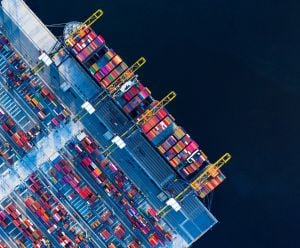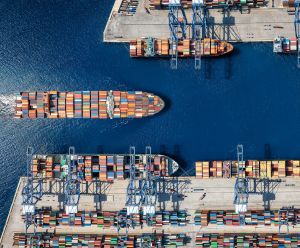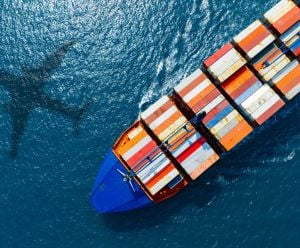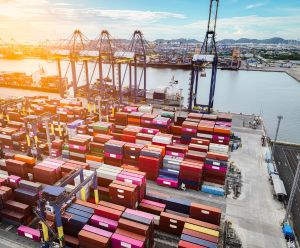
Carriers adopt varying capacity strategies amid softening rates

Sluggish demand from key import countries is encouraging container lines to withdraw capacity. The aim is to stave off further rate declines, not least on the trans-Pacific trade, where long-term contract negotiations are in full swing.
However, withdrawals vary significantly by carrier and trade, with divergent liner strategies becoming clearer. Concurrent with capacity cuts, there are tangible signs that container shipping demand might recover in the second half of the year.
Financial firm Nomura’s leading index of Asia ex-Japan’s aggregate exports saw a slight improvement to 78.3 in April, driven by the re-opening of China’s economy and slight improvements in tech indicators. This could be “durable turning point” and Asian export growth could recover in the second half of the year.
“Although inflation is a persistent drag on demand, the re-opening of China has given supply chain stakeholders a real boost. We have observed a much stronger month of March versus the prior two months,” said Kelvin Leung, CEO, DHL Global Forwarding Asia Pacific. “Based on the first three weeks of the April trading, we are more optimistic about the outlook for the second half of 2023.”
Idled fleet
However, optimism on the demand side has not stopped the downward slide of container shipping spot freight rates on most trades. As a result, carriers are still withdrawing capacity.
March saw the biggest jump in 36 months in the idle containership fleet. According to Drewry Shipping Consultants, this has increased to 300,000 TEU in the first part of the month to reach a total capacity of 1.37m TEU. Carriers accounted for 57 percent of the inactive units, while 43 percent of the cuts came from independent non-operating owners.
Drewry Shipping Consultants noted that March’s rise was the sixth largest monthly increase in the past 10 years, behind the 800,000 TEU that joined the idle ranks in February 2020, when demand for containerized goods was widely expected to crash in the wake of Covid-19. The latest sum represents 5.3 percent of the cellular containership fleet (25.8m TEU) and is the highest ratio since August 2020.
The percentage is expected to continue rising in the coming months. The challenge is particularly acute for carriers, given the “colossal orderbook” which will see a new wave of ships entering service through the year.
The untangling of supply chains has also increased the effective capacity of the global fleet as congestion at ports has dissipated. Analyst firm Sea-Intelligence concluded that a capacity loss of 6.2 percent in January due to congestion this year represented “roughly two-thirds of the way back to a normality of 2.2 percent” from the peak vessel congestion witnessed in January 2022.
Last-minute blanks
Schedule changes by carriers thus far this year have been far more disruptive to trans-Pacific shippers than to those utilizing Asia-Europe services. On the former lane, Sea-Intelligence found that weekly scheduled capacity more than two weeks ahead of actual departure was considerably higher than what was eventually deployed. On the Asia-North Europe trade, deployed and scheduled capacity were more closely correlated.
Carriers have also been attempting to fortify earnings by implementing General Rate Increases (GRI), most notably on the India-US trade, although these efforts' effectiveness is unclear.
The April DHL Ocean Freight Market Update notes that global freight rates were continuing to slide, but at a much slower pace, and some local GRIs proved unsuccessful.
Rates war ongoing?
Liner idling strategies are also diverging. Alphaliner reported that Maersk had idled 17 vessels of over 7,500 TEU capacity in mid-March. Its 2M partner MSC had idled seven ships, but no other carrier had idled more than three vessels.
“Freight rates are in some cases already below pre-pandemic levels,” said Lars Jensen, CEO, Vespucci Maritime. “The fact that the carriers still do not remove sufficient capacity to match the demand decline implies that some carriers favor volume increase over rate levels – and hence there is a de-facto small rate war ongoing.”
This view is supported by recent movements in the ship charter market. Even though inventory levels remain high and a wave of new ships is entering service, the rates paid by container lines to charter ships is now rising. Meanwhile, the expected surge to scrap vessels has not materialized and container lines continue to place new orders.
“It would appear from carrier statements that they expect a potential market rebound in peak season 2023,” added Jensen. “If the current market downturn is solely driven by an inventory correction, and consumer spending holds up, then this expectation could indeed prove correct.”
Alternative storms
Alternatively, overcapacity could continue, with carriers within individual alliances unable to agree on pulling capacity. This could intensify the rate war in the months ahead leading to rates not bottoming out for a few months. It might even fall to the extreme levels last seen in 2016.
The situation in the coming months could go both ways. “One where the inventory correction ends, and demand grows sharply – also prompting sharp increases in rate levels already in summer 2023. And another where the rate war intensifies sending levels much lower,” said Jensen.
Contract rates, however, are continuing to deliver healthier returns in 2023 than spot market declines would suggest. John McCown, founder of Blue Alpha Capital, predicts that despite drops in spot rates this year, carriers will still record their third best combined annual results in the history of the sector.
“There are very mixed messages coming from container lines right now,” said Leung. “I think we’ll see a divergence in strategy by carriers and alliances. How this plays out in terms of service levels remains to be seen.”
MORE FROM THIS COLLECTION














 English
English